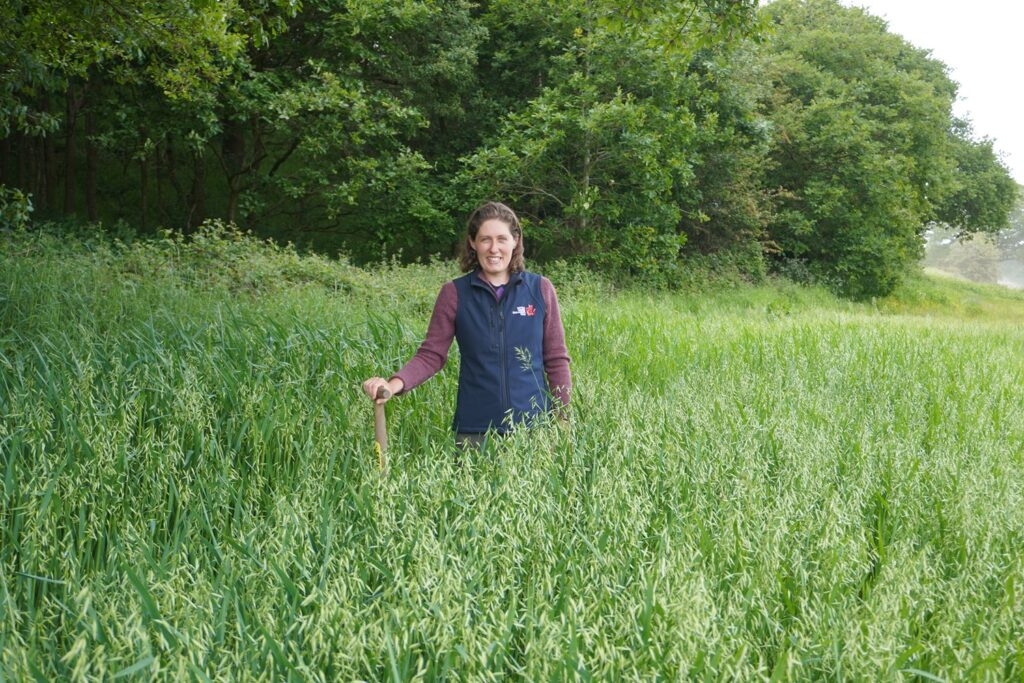Can how you grow crops impact on the nutrient and health value of food? It’s what farmer and doctor Hannah Fraser is trying to find out on a Nuffield Scholarship
By Mike Abram
For a long time there has been a suspicion that how you grow food will determine its nutrient status and ultimately impact how healthy consumers are. It’s a claim some in the organic farming sector, and more recently regenerative farmers have tried to make but is there evidence to back that up?
That’s what motivated first generation farmer Hannah Fraser to investigate the topic for her Nuffield Scholarship.
“Five years ago, I knew very little about food production,” she says. That was the moment she and her husband Alex took on farming the land around the family home at Denby Hall Farm, near Huddersfield in Yorkshire.
Deciding to farm organically, Hannah and Alex, the pair have embraced practices designed to restore soil health as quickly as possible.
Linking how farmers can impact the health and nutritional value by how they farm was a natural step given Hannah’s day job as a medical doctor at a Leeds hospital.

“I’ve learned a lot working in the medical profession,” she says. “Sadly we have a real issue in this country with chronic diseases, such as diabetes, high blood pressure, dementia and heart disease. They don’t go away easily, often requiring a lot of medication and follow up, impacting quality of life.”
In the UK, she says, just under half the adult population suffers from at least one of these conditions, and while life expectancy is a reasonable 81 years, the age to which we’re expected to live well with no medical problems is only 63.
“What’s more worrying is these numbers are in decline, so our health is potentially getting worse.”
A lot of research shows the importance of food and diet in reducing disease risk, but, while nutritionally dense food is far from a new concept, much less research has been conducted linking how food has been grown to nutrient richness and our health.
There are essentially three components to food that determine nutrient density – macronutrients, micronutrients and phytochemicals.
Macronutrients are the big things – proteins, carbohydrates, fats and fibre, Hannah explains, while micronutrients are the vitamins and minerals present in small amounts. Phytochemicals include thousands of plant-made chemicals, such as beta-carotenes, anthocyanins, phenols and flavonoids.

“Macronutrients often get talked about more in dietary recommendations, but I think it is the micronutrients that can really make a difference to our health. We can’t make these ourselves, so they have to come in our diet.
“In high income countries, where people are relatively calory-secure, just under half of children under the age of five and half of women of reproductive age are deficient in at least one of these micronutrients, so how nutritious our food is could make a real difference.”
Research is also finding phytochemicals have remarkable effects in the body including anti-cancer properties and reducing inflammation, which can be an important component of those chronic conditions.
“It’s why we get told to eat a variety of fruit and veg; eat the rainbow.”
But there are a huge number of unknown phytochemicals in food, which have unknown impacts of our health or how farming systems influence their levels, she adds.

So has the nutritional levels in food declined? Some data suggests it has – a group of scientists compared UK government data between the 1930s and 1980s in 20 vegetable and found 19% lower calcium, 35% less magnesium, 22% iron, 81% copper and 14% less potassium, Hannah says.
“Similar findings have been found in US and Finnish data, although there is criticism of this data. Testing will have improved since the 1930s, and there could have been errors, such as tiny traces of soil left on food which would have made the nutrients levels higher.”
What about testing today’s food and seeing if it varies? That’s what US-based Bionutrient Food Association is hoping could be possible with a handheld device, Hannah says. “To calibrate the device they’ve been taking food samples from across Europe and the US to see how the amount of nutrients varies.”
And the answer is in some foods it can vary a lot. For example, in kale the amount of calcium can vary between 15% and 40% of the recommended daily intake, so at the lower side you would have to eat three times as much to get the same amount of calcium.
The same applies for some other nutrients and vegetables, while similar analysis for polyphenol and antioxidant phytochemicals shows wide variations in some fruit and veg.
“We can’t say what the health impact that is as we don’t know how many phytochemicals you need to be healthy.”
So can we produce more nutrient dense food through changing the way we farm? That’s what those farming using regenerative or organic practices hope, and there is some evidence starting to emerge that might be the case.
Geologist and author David Montgomery and partner Anne Bikle, a biologist, have set up a preliminary trial comparing 10 regenerative farms with conventional counterparts in the USA.
Early trial data suggests, for example with cabbages, the regeneratively farms are producing food with more nutrients. “For vitamin K, 30% more of the amount that you need in a day was in the regenerative cabbage compared with conventional, and 10% more vitamin C.
“In wheat and oats, there was quite substantial differences in mineral content, but it’s just 10 farms so we can’t draw conclusions yet, and shows what a study looks like.”
Other studies have shown higher amounts of ergothioneine, which is produced by fungi and nicknamed the longevity vitamin because it seems to prevent ageing, is found in soybeans and oats produced in a no-till system compared with plough-based establishment.
“It’s an interesting example of how a healthy soil might be providing different compounds,” Hannah suggests.

Or there’s the study showing higher abundance and diversity of beneficial microbes on salad grown in soil compared with grown in a sterile vertical system. These microbes might be helping to populate our gut microbiome, keeping us healthy.
Breeding varieties with higher nutrient density is also possible, as shown by Harvest Plus, a group working in developing countries using conventional breeding to increase iron, vitamin A and zinc in crops.
“Could we breed a wheat that’s high in zinc, iron and copper?” Hannah asks. Already in Finland a programme to apply a foliar selenium fertiliser to wheat has helped solve a deficiency issue in its population.
In livestock agriculture, researchers have found the amount of forage in dairy diets balances the ratio of omega 6 to omega 3 fatty acids in milk to around 1:1 when the animals are fed 100% of forage, compared with 8:1 when there is minimal forage in diets.
This is important as in modern diets we’re consuming around 16 times more omega 6 than omega 3 and scientists think this could be promoting inflammation causing heart attacks, Hannah explains.
“So 1:1 is more in line what might be healthier for us,” she says. “And the same 1:1 ratio has been seen with grass-fed beef compared with 10:1 for cattle finished on a mixed ration.
“There were also a lot more phytochemicals in grass-finished beef.”
Those research findings are giving confidence to Hannah that there is real evidence that different farming techniques can produce healthier, more nutritious food, although more is required and will be needed to convince the public and for policy makers to put in the right incentives for farmers to switch practices.
“We’re in the early days of recognition of the link between farming and health,” she says.
Harking back to a quote in 1943 by Lady Eve Balfour, a British organic farming pioneer, that spoke of the connection between health and correct soil management and the need for any public health system to be connected to soil fertility, Hannah hopes that farmers will be recognised for the important role they play in public health.
“Maybe one day like today when we’re starting to be paid for ecological services, we’ll start to be paid for health services for the role we play in producing nutritious food,” she concludes.



